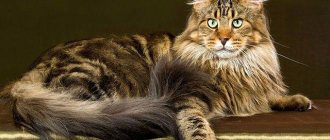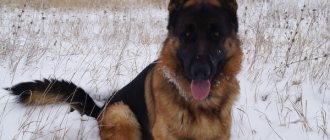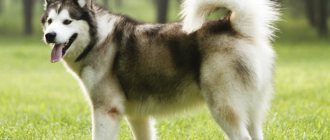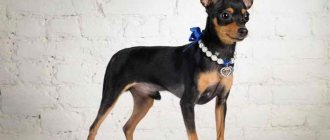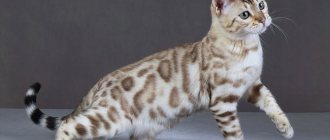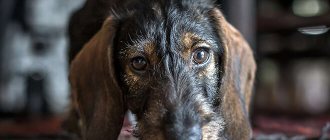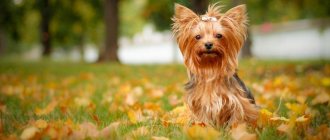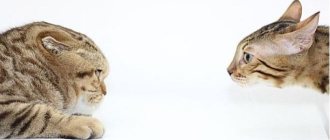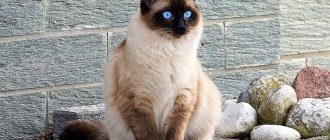The British Shorthair is a purebred version of the traditional English cat, with a characteristic stocky body, densely padded coat and broad muzzle.
The most familiar color variant of British cats for the average person is blue or blue; this is a solid blue-gray coat, copper eyes and a medium-sized tail.
Few people know that this breed has also been developed in a wide range of other colors and patterns, including tabby and various color morphs.
A little history of the breed
They are one of the oldest known breeds, descended from European domestic cats imported to England at the same time as the Roman invasion in the first century AD. Today it remains the most popular breed in its native country, as registered by the UK Governing Council for Cat Fancy (GCCF).
The origins of the British Shorthair most likely date back to the first century AD, making it one of the oldest identifiable breeds in the world.
It is believed that the Roman invasion originally brought Egyptian domestic cats to Britain. These animals were then interbred with the local European wild cat population. Over the centuries, their natural isolated descendants evolved into very large, robust beasts with short but very dense hair, to better withstand the rather harsh climatic conditions of their home islands. Based on artists' views, the modern British Shorthair is no different from this original type.
On the left you see blue colors. On the right are the tabby, red, cream and cinnamon varieties in the first photo, tortoiseshell in the second and bicolor in the third.
Selective breeding of the best specimens of this breed began in the nineteenth century, with an emphasis on developing an unusual blue-gray variant called the "British Blue" or "English type" (to distinguish it from the finer-grained "Russian").
Some sources directly credit British artist and cat lover Harrison Weir with the original concept for standardizing the breed. Others suggest that a group of breeders was involved in the selection.
The new British Shorthair was introduced at the first ever cat show, organized by Weir at the Crystal Palace in London in 1871, and enjoyed great initial popularity.
British golden chinchilla
By the way, you can read the article about the British golden cat.
By the 1890s, with the advent of newly imported Persians and other longhair breeds, the British Shorthair was no longer as widely popular, and its breeding stock became critically rare during the First World War.
At least partly to save the breed, breeders mixed Persians with their bloodlines. The genes introduced in this way would eventually become the basis of the British Longhair. At that time, any longhaired cats produced were included in the Persian breeding program, as all blue cats were then rated together as non-de facto single breed options. Blue Shorthairs, the result of crossing the early British with Russian Blues, were also common.
Blue color
After the war, in an attempt to maintain the breed standard, the GCCF decided to accept only third generation Perso-British Shorthair crosses for registration. This also contributed to the destruction of the pure breeding stock by the beginning of World War II, after which the Persian and Russian Blue were reintroduced to the list of acceptable crosses.
Blue kitten
In addition, felinologists have also worked with the French Chartreuse, another ancient breed that, although not genetically related to the British Blue, is very similar visually. Breeders devoted much attention to restoring the true English type, and by the late 1970s the British Shorthair had received official recognition from both the Cat Fanciers' Association (CFA) and the International Cat Association (TICA).
Blue color
It is again the most popular cat breed in the UK, according to the GCCF 2013 registry.
Standard requirements for tortie cats
Tortoiseshell cats should have a harmonious-looking coat of colored spots uniformly distributed over the surface of the body. The classification accepted by felinologists distinguishes two types of distribution of color spots:
- small spots of red and black groups;
- patchwork coloring of red, black and white colors.
The British cat's coat is short, dense, soft to the touch, slightly raised. Often compared to a wool rug. Tortie's eye color is a rich dark gold or copper. The color of the tip of the nose and paw pads can be pink, black or mixed pink and black.
Photo - fold cat f 21 01
BRI h 03
Brief description of British cats
The British Shorthair is a rather powerful-looking large cat with a wide chest, strong thick legs with rounded paws and a medium-length tail with a blunt tip. The head is relatively large and rounded, with a short muzzle, wide cheeks (most noticeable in mature males, which tend to develop prominent jaws) and huge round eyes, which are dark copper-orange in British Blues and in others cases vary in color depending on the coat. Their ears are large and set wide apart.
The British Blue variant can often be confused with the Gray Scottish Fold. However, in shorthairs the difference can be characterized by the presence of sharp triangular ears, while in Scottish cats they are soft and folded.
Scottish Fold cats
are slower to mature than most cat breeds, reaching full physical development at approximately three years of age.
Unusual among domestic cats, they are a noticeably sexually dimorphic breed, with males averaging 4.1–7.7 kg and females 3.2–5.4 kg.
Silver chinchilla
Blue color
Lilac color
Blue color
Bicolor
Blue color
The British Shorthair is one of the defining characteristics of the breed. It is very dense, but has no undercoat. Thus, the texture is soft rather than downy or fluffy, with a hard, "fresh" coat that visibly "breaks" throughout the cat's body as it moves.
British Blue is still the most familiar variety, however British Shorthairs have been sectioned into many other colors and patterns. Black, blue, white, red, cream, silver, gold and, more recently, the cinnamon (cinnamon) and fawn colors are accepted according to all official standards, either solid or colored, tabby, shaded and two-tone.
Golden chinchilla
Felinological associations GCCF, FIFe and TICA also accept the color chocolate and its diluted shade lilac, prohibited by the CFA standard. All colors and patterns also have tortoiseshell options.
Tabby patterns include the following varieties:
- Classic tabby;
- Tabby Mackerel;
- Spotted and tabby marked.
Non-tabby patterns include the types:
- Turtle cake;
- Two-tone bicolor;
- Two-tone with white;
- Smokey tuxedo;
- Color-point.
British Blue Cat
Temperamentally, this is a calm and dignified breed, not as active and playful as many others, but good-natured and devoted to their owners, which makes them favorite trainable pets.
They are generally safe around other pets and children, as they will tolerate a fair amount of physical interaction, but generally do not like to be picked up or carried. They require only minimal care and are easy to keep, however, they can be prone to obesity if care is not taken with diet.
The English Breed Committee considers the British Shorthair to be a long-lived cat with a life expectancy of 14-20 years. Data from veterinary clinics in England shows an average of 11.8 years. According to Swedish statistics, the average life expectancy of the breed is more than 12.5 years. 82% of British Shorthairs lived to 10 years or more, and 54% to 12.5 years or more.
Blue color
Although a condition such as hypertrophic cardiomyopathy (HCM) can be a problem in the breed. A study of its prevalence in Denmark involving more than 329 cats found that 20.4% of males and 2.1% of females had HCM. In addition, 6.4% of males and 3.5% of females were considered at risk. HCM testing of cats used for breeding is now mandatory for breeders organized under the authority of member Fife Denmark.
The breed is considered to be at high risk for polycystic kidney disease (PCD). The DNA testing laboratory noted a significant reduction in PKD mutations in the populations tested.
Golden British cats
Collor Point breed
These animals include those in which there are two colors in color, but white significantly predominates. The second color can range from gray with a lighter shade to red. The most expensive representatives of the breed with a very rare Siamese type color with dark colored locks.
Silver and gold shaded
Representatives of this category are characterized by the presence of the main color on the ears, head, back and even on the tail. In this case, the silver shade should predominate on the collar, paws and belly. Quite often, all owners of this color are mistakenly called chinchillas. Among them are the colors of the coat:
- brown or black;
- blue;
- chocolate;
- cinnamon;
- faun
Silver chinchilla
If we talk about what colors British silver cats come in, then this category can be classified as the rarest. Thanks to the direct connection with representatives of the Persian breed, they have a more flexible and softer character.
Golden color type
In this group of animals, the base tone is necessarily dark, and the upper part of the hair is painted gold. A gray tint in this case is not acceptable, and therefore such cats are considered defective. People call them chinchillas.
shutterstock
Turtle animals
Owners of tortoiseshell colors are characterized by a uniform distribution of tones on the body, but with the condition that there are no patterns on the light parts. It is acceptable to have red or cream spots on the face. This species, due to genetic predisposition, is only possible for females, which makes the work of breeders even harder. Another injustice is that the British in this category are infertile
For animals, a combination of 3 colors is important:
- black or brown;
- cream/red;
- blue or purple.
Patterned (Tabby)
Another species that contains a table of colors of British cats. What is characteristic of these Britons is that they can have excellent hair color at the very base. The pattern on the body can be striped or spotted. It is advisable to divide them into silver and gold types; sometimes a subspecies of the Collor Point type is also distinguished.
Snow (asymmetrical) leopard color
This type of tabby is characterized by large dark spots on a light-colored coat. The pattern practically cannot be symmetrical, and the spots themselves are dark inside and less saturated along the contour. On the lateral areas of the skin there are thin stripes resembling marble. The kittens' eyes are large and copper-colored. The base tone can be anything.
The brighter the color of the ornament in the first months of the animal’s life, the better it will be preserved as it grows.
Whiskas
Like all British cats, this one has a special charm. Silvery fur with a clear pattern on the body characterizes representatives of this group. The main feature is three solid lines on the back of the animal. His eyes are always bright orange. The base is a light gray color, respectively, the line is dark gray or black.
Bicolor, Party-color and others
Such obscure names hide the spotted coat colors of some Britons. This is a certain combination of white with the base color. Bicolor has the same type of spots, and white color occupies no more than half of the body. Party colors are characterized by the presence of spots with certain patterns. Harlequin is at least 80% white, and Van is no more than 80%.
Colors of British Shorthair cats
The British Shorthair is England's favorite cat, and it's easy to see why: its large, muscular body, loving but often whimsical temperament, and array of colors and patterns mean it's a breed suitable for many lovers.
Some British Shorthair colors are very well known, but the variety has many excellent color isomorphs and patterns, and new types are emerging all the time.
British merle color
There is a huge variety of British Shorthair colors.
Black color group
The British "Bagheera" is divided into different types:
- Black British Shorthair. An animal with the right characteristics is a real beauty - expressive amber eyes looking out from a deeply pigmented black background always remind one of the black panther from The Jungle Book. This is an amazing cat of extraordinary beauty.
- British Blue is also part of the black group of solid colors and is the best known color for this breed. This is a rather misleading description because "blue" is actually grey. It's easy to see why this is such a popular shade, with its wonderful muted steely tones. British Blue is an instantly recognizable beauty. All blue cats are actually genetically black cats with an additional breeding gene that reduces the amount of pigment in the fur, creating a blue/gray tint to the coat.
- British shorthair chocolate color. The deep rich color is incredibly unusual and loved by many people.
- The British Shorthair "lilac" has a very unusual and beautiful coat color, lilac is a very warm gray. This is actually a chocolate cat with a dilution gene that reduces the pigment in the fur and makes the chocolate a bluish tint.
- The Cinnamon British Shorthair is a relatively new color in the breed and is similar to chocolate but with a warmer, reddish tint.
- Fawn British Shorthair is also one of the new colors. Fawn is a cinnamon with a dilution gene that makes the pigment less concentrated and creates a very soft deer hide color. The fur is very similar to lilac, but a little softer and more subdued.
Red British Shorthair
While all other colors come from the black gene, red and cream, its diluted colors, are independent.
All ginger cats will have some sort of stripe markings visible, but a show animal should have as few visible line markings as possible.
A rich, deep red is the most desirable color in the competition, but it can range from pale red to deep burgundy.
The Cream British Shorthair should be a lovely light brown shade with no hint of ginger. Cream is a diluted red gene, so it is difficult to achieve beautiful cream cats without red undertones.
Cream color
White British Shorthair
The white gene is an additional allele that lies on top of other patterns and has the effect of masking color shades, making the fur light.
All white cats are essentially genetically colored animals, but with a white gene.
British shorthair patterns
The term Selfs is used to describe any British Shorthair of one solid color.
In addition to solid colors of different shades and colors, this breed has various groups of coat patterns:
- Tortoiseshells. Only female British Shorthairs can be Torties because this gene is linked to sex. The tortoiseshell cat has one gene for black and one for red, both of which are visible in the fur. Black cakes - black and red, blue - blue and cream, chocolate - light cinnamon and red, lilac - lilac and cream, brown - cinnamon and red, fawn - fawn and cream. The ideal British Tortoiseshell should have a beautiful mixture of two different colors throughout the coat, creating a mottled effect.
Blue cake
Blue cake
- Bicolor. Bi-colored British Shorthairs are very colorful cats. They can be any color and are accompanied by white markings, which are usually found on their face, belly and paws, but the markings sometimes appear anywhere on their body. Bicolored Britons can be less than 50% white or more, depending on their genetic makeup. The white spot allele is different from the white gene. The latter prevents the pigment from spreading throughout the body while the kitten is still in the womb.
- Calicos are tri-colored cats based on bi-colored tortoiseshells. The white spotting gene influences the tortie's pattern, causing it to appear in marks of color rather than fine spotted markers throughout the coat.
- Color point. Such Britons can come in any possible color of the breed. The "color point" gene prevents the development of color on warmer parts of the body (higher temperature), and the effect of this phenomenon is that the animal's limbs, tail and face are darker in color than the body (points).
- Tabby. In fact, all cats are tabby, but there is a gene that hides the tabby pattern. Striped animals do not have this additional allele. British shorthair Tabbies come in a variety of colors including silver, gold, blue, lilac, cinnamon and fawn, and can also be color-pointed or bi-colored.
You can stay with the tabby a little longer, as this color has interesting variations:
- The Silver Tabby is a very popular British Shorthair cat. She is a black tabby with a special gene that makes her background color silver instead of a warmer shade. Their markings are striking, in any variety of banding.
- Mackerel tabby - the British coat in this case is striped, like a miniature tiger.
- Classic tabby is a merle or marble color in various variations.
- Spotted tabby - the coat has characteristic round markings of a darker shade than the main background.
The colors and varieties of British tabby are striking, for example there are blue and gold mackerel with unusual patterns written in gold script on a deep blue background.
Also read about British Chinchilla cats.
Classic colors
Today there are about 200 different types of British wool colors. However, all this motley diversity is clearly regulated. There is a whole system of international norms and standards, gradation of color according to a point system. Specialists in the field of felinology evaluate each kitten submitted to them for examination and assign it a unique code, which is recorded in the animal’s pedigree.
The assessment is influenced by many different factors: general genetics, color compatibility of the couple, how closely related the parents are to each other. One color gene may predominate over another - this also affects the resulting offspring.
The main points on which the assessment is carried out:
- intensity of coat and undercoat color;
- presence or absence of a picture;
- the color of the eyes, pads on the paws, as well as the color of the tip of the kitten’s nose.
All the current color varieties of British cats can be divided into several main groups.
Solid colors. They are also called solid or solid. The main requirement for them is that the color must be uniform.
The following solid colors are considered classic.
Black. Cats of this color are quite rare, so they are highly valued on the market. Black wool is hard to the touch by standard and has a beautiful sheen. The animal must be black, without exception, from the pads of its paws to the tip of its nose. Some concessions can be made for eye color: in addition to the usual green, copper and golden shades are allowed. The purity of the breed also depends on the undercoat - its color must exactly match the color of the coat.
The paws and nose should be the color of the coat, the eyes are traditionally copper or orange.
Ideal British Shorthair eye color based on coat color
Speaking about the colors of the British Shorthair breed, it is worth mentioning the shade of the eyes in each category, as this is very important for the correct assessment of the animal.
Below is a table of the correspondence of the shade of the cornea of the British Shorthair's eyes to the fur color.
| Eye color | Wool shade |
| Orange, amber, gold | Black and blue. |
| Chocolate and lilac. | |
| Cinnamon (cinnamon) and fawn. | |
| Red and cream. | |
| Blue | Color-point colors. |
| Green, brown, orange, amber, gold | Silver tabby. |
| Emerald | Silver. |
| Golden smoke. | |
| Copper shaded. | |
| Green, blue, orange, colorful | White. |
Eye color is determined by the amount of pigment in the iris. If there is a lot of it, the cornea will have an orange tint, while in the complete absence it will have a blue tint. Green and yellow tones lie somewhere in the middle of these two extremes.
Most domestic cats have yellow or green eyes, which fall in the middle of the spectrum. Eye color in British Shorthairs must be actively and selectively bred to maintain it at the very end of the color scale.
A dilution program that does not take eye color into account ultimately results in a dilution of the desired shade, with all corneal tones shifting toward the middle of the spectrum and ending up yellow or green.
Look at the handsome blue-eyed Briton Kobe:
British Blue eye color
Blue British Shorthairs have been bred widely and over a long period of time, so the characteristics of the British Blue color have a fantastic opportunity for development.
The result is many blue British Shorthair cats with a fantastic orange eye tint, although this is a very difficult color to breed.
Blue color with yellow eyes
Shorthair British Chocolate Lilac
Chocolate and lilac colors have recently been introduced in this ancient breed.
Bicolor with base lilac and dark orange eyes
As a result, it is much more difficult to find chocolate or lilac British Shorthairs with exceptional orange eye color: most "chocolate" and "lilac" have irises of yellow or amber shades. Although some breeders managed to get incredibly orange eyes from lilac shades of color.
Cinnamon and fawn British Shorthair color
Cinnamon and fawn coat colors have appeared more recently, and the eye color of these animals is similar to the shade of “chocolate” and “lilac”, but less developed and not as rich.
Color cinnamon
Color Point British Shorthair
For breeders of English cats of this color, the goal is to have the eyes as blue as possible and this is a very difficult task.
Color point kitten with blue eyes
Most colorpoints have silver-blue eyes. They are incredibly beautiful in their own right, and many people actually prefer silver tones over bright blue.
For show judges, however, preference is given to colorpoints with bright blue corneas. They have no pigment at all - they are not actually blue, but pure.
Silver irises have very little pigment.
Professional breeding and eye color of the British Shorthair
Ultimately the eye color that is preferred in an animal is a personal choice of the breeder and will obviously not affect the purity and beauty of the breed.
British tabby cats
If the goal of purchasing a British cat is to participate in competitions and exhibitions, then you need to choose a good nursery with a breeder who understands genetics and has some breeding experience.
A good experienced breeder will be able to help the client choose their most suitable kitten.
British Shorthair kitten - correct eye coloring
All British Shorthair kittens are born with blue eyes. Gradually, as they grow older, they acquire their true color.
This transition begins when the cubs are about 6-8 weeks old and continues until they are about 2 years old, when they finally reach their full colors.
Blue kitten
For example, a blue British Shorthair kitten is born with blue eyes, and these will then change color to a variety of shades, including dirty brown and green, before the color is fully developed.
It should be remembered that no matter what the final eye color is, the kitten will always have blue eyes.
Eye color and choice of matings
Breeders should pay attention to the animal's eye color when choosing a breeding pair, especially if these matings occur between cats with different shades of irises.
Torti or tortoiseshell color
Tabby
Golden chinchilla
Tabby Golden Chinchilla
White color
Some breeders never mix cats with different eye colors together. However, there are often features that you can have in one color line that you would like to present in another shade type.
For example, British Blues are often very stubborn cats, and a breeder may want to introduce a little more of this trait into a Color Point or Silver Tabby line.
Tabby
Likewise, breeding between colors can be very helpful in maintaining genetic diversity within them, ensuring that there are enough cats with a wide range of patterns to continue that type in a healthy way.
It is known, for example, that silver tabbies need more genetic diversity.
Its good-natured appearance and relatively calm temperament make the British Shorthair a frequent media star, most notably as the inspiration for John Tenniel's famous illustration of the "Cheshire Cat" in Alice in Wonderland.
The Cat Fanciers' Association profile reads: "When ingenuousness is observed, the British Shorthair is suitably embarrassed, quickly appearing with a 'Cheshire Cat smile'."
Character traits
British cats are very affectionate and friendly creatures. They are quite sociable, communication skills are their strong point. This cat gets along very easily with everyone with whom she has to live in the same space. A British woman can follow a person until he gives her the opportunity to sit next to her comfortably. British cats love children very much, which is an important factor. They get along quite easily with other animals, including dogs.
The British cat has an independent character, the coat does not require special care, the animal copes with its coat itself. This animal is very suitable for those people who spend most of their time at work. They are also called “businessman’s cat.” A cat is very similar to a plush toy, but it should not be treated like a toy. The animal will patiently do everything that does not humiliate its advantages given by nature.
A British cat must be handled carefully and calmly. The British cat does not require careful training; she is smart enough to figure out everything she needs on her own. Even at a young age, a kitten will never relieve itself where it is not supposed to, and will not sharpen its claws on luxurious furniture. A small disadvantage of this breed is that the animal does not really like to sit in your arms, and may become indignant if you try to forcefully pick up the cat.
But if you have a great desire, and most importantly, the opportunity, it is definitely worth adopting this breed. A huge selection of animal colors will suit the taste of any person. They do not require special care and will make an excellent friend and pet.
But there are also many disadvantages of this breed, which can serve as a decisive factor when choosing. Cats, no matter what, are hunters, so it is necessary to provide the opportunity to realize this instinct. It will be necessary to additionally purchase appropriate play complexes for the animal, which are sold in specialized stores.
See the video below about the character of British cats.
